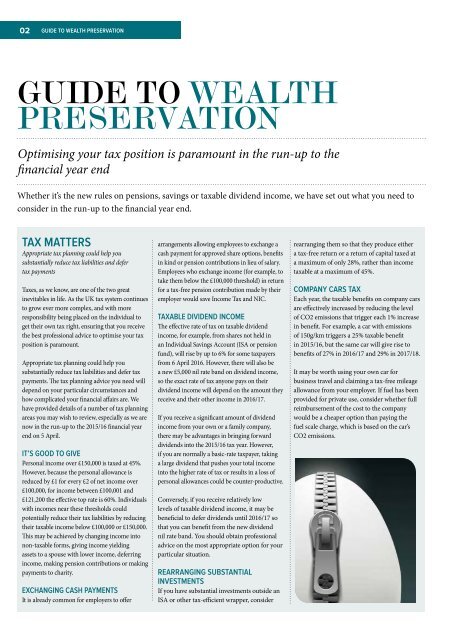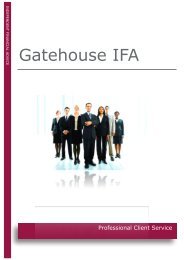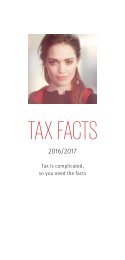wealthguide
Create successful ePaper yourself
Turn your PDF publications into a flip-book with our unique Google optimized e-Paper software.
02<br />
GUIDE TO WEALTH PRESERVATION<br />
GUIDE TO WEALTH<br />
PRESERVATION<br />
Optimising your tax position is paramount in the run-up to the<br />
financial year end<br />
Whether it’s the new rules on pensions, savings or taxable dividend income, we have set out what you need to<br />
consider in the run-up to the financial year end.<br />
TAX MATTERS<br />
Appropriate tax planning could help you<br />
substantially reduce tax liabilities and defer<br />
tax payments<br />
Taxes, as we know, are one of the two great<br />
inevitables in life. As the UK tax system continues<br />
to grow ever more complex, and with more<br />
responsibility being placed on the individual to<br />
get their own tax right, ensuring that you receive<br />
the best professional advice to optimise your tax<br />
position is paramount.<br />
Appropriate tax planning could help you<br />
substantially reduce tax liabilities and defer tax<br />
payments. The tax planning advice you need will<br />
depend on your particular circumstances and<br />
how complicated your financial affairs are. We<br />
have provided details of a number of tax planning<br />
areas you may wish to review, especially as we are<br />
now in the run-up to the 2015/16 financial year<br />
end on 5 April.<br />
IT’S GOOD TO GIVE<br />
Personal income over £150,000 is taxed at 45%.<br />
However, because the personal allowance is<br />
reduced by £1 for every £2 of net income over<br />
£100,000, for income between £100,001 and<br />
£121,200 the effective top rate is 60%. Individuals<br />
with incomes near these thresholds could<br />
potentially reduce their tax liabilities by reducing<br />
their taxable income below £100,000 or £150,000.<br />
This may be achieved by changing income into<br />
non-taxable forms, giving income yielding<br />
assets to a spouse with lower income, deferring<br />
income, making pension contributions or making<br />
payments to charity.<br />
EXCHANGING CASH PAYMENTS<br />
It is already common for employers to offer<br />
arrangements allowing employees to exchange a<br />
cash payment for approved share options, benefits<br />
in kind or pension contributions in lieu of salary.<br />
Employees who exchange income (for example, to<br />
take them below the £100,000 threshold) in return<br />
for a tax-free pension contribution made by their<br />
employer would save Income Tax and NIC.<br />
TAXABLE DIVIDEND INCOME<br />
The effective rate of tax on taxable dividend<br />
income, for example, from shares not held in<br />
an Individual Savings Account (ISA or pension<br />
fund), will rise by up to 6% for some taxpayers<br />
from 6 April 2016. However, there will also be<br />
a new £5,000 nil rate band on dividend income,<br />
so the exact rate of tax anyone pays on their<br />
dividend income will depend on the amount they<br />
receive and their other income in 2016/17.<br />
If you receive a significant amount of dividend<br />
income from your own or a family company,<br />
there may be advantages in bringing forward<br />
dividends into the 2015/16 tax year. However,<br />
if you are normally a basic-rate taxpayer, taking<br />
a large dividend that pushes your total income<br />
into the higher rate of tax or results in a loss of<br />
personal allowances could be counter-productive.<br />
Conversely, if you receive relatively low<br />
levels of taxable dividend income, it may be<br />
beneficial to defer dividends until 2016/17 so<br />
that you can benefit from the new dividend<br />
nil rate band. You should obtain professional<br />
advice on the most appropriate option for your<br />
particular situation.<br />
REARRANGING SUBSTANTIAL<br />
INVESTMENTS<br />
If you have substantial investments outside an<br />
ISA or other tax-efficient wrapper, consider<br />
rearranging them so that they produce either<br />
a tax-free return or a return of capital taxed at<br />
a maximum of only 28%, rather than income<br />
taxable at a maximum of 45%.<br />
COMPANY CARS TAX<br />
Each year, the taxable benefits on company cars<br />
are effectively increased by reducing the level<br />
of CO2 emissions that trigger each 1% increase<br />
in benefit. For example, a car with emissions<br />
of 150g/km triggers a 25% taxable benefit<br />
in 2015/16, but the same car will give rise to<br />
benefits of 27% in 2016/17 and 29% in 2017/18.<br />
It may be worth using your own car for<br />
business travel and claiming a tax-free mileage<br />
allowance from your employer. If fuel has been<br />
provided for private use, consider whether full<br />
reimbursement of the cost to the company<br />
would be a cheaper option than paying the<br />
fuel scale charge, which is based on the car’s<br />
CO2 emissions.




